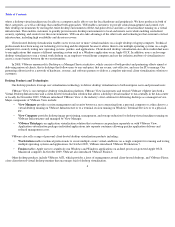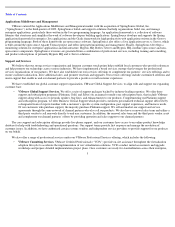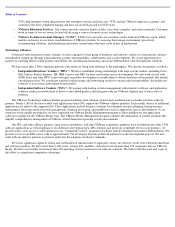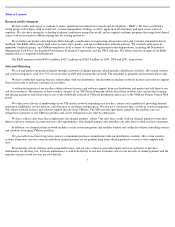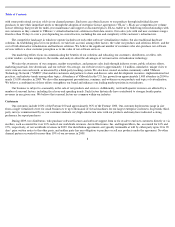VMware 2009 Annual Report Download - page 17
Download and view the complete annual report
Please find page 17 of the 2009 VMware annual report below. You can navigate through the pages in the report by either clicking on the pages listed below, or by using the keyword search tool below to find specific information within the annual report.
Table of Contents
Our operating results may fluctuate significantly, which makes our future results difficult to predict and may result in our operating results
falling below expectations or our guidance, which could cause the price of our Class A common stock to decline.
Our operating results may fluctuate due to a variety of factors, many of which are outside of our control. As a result, comparing our
operating results on a period-to-period basis may not be meaningful. Our past results should not be relied upon as an indication of our future
performance. In addition, a significant portion of our quarterly sales typically occurs during the last month of the quarter, which we believe
generally reflects customer buying patterns for enterprise technology. As a result, our quarterly operating results are difficult to predict even in
the near term. If our revenues or operating results fall below the expectations of investors or securities analysts or below any guidance we may
provide to the market, the price of our Class A common stock would likely decline substantially.
In addition, factors that may affect our operating results include, among others:
14
•
general economic conditions in our domestic and international markets and the effect that these conditions have on our customers
’
capital budgets and the availability of funding for software purchases;
•
fluctuations in demand, adoption rates, sales cycles and pricing levels for our products and services;
•
fluctuations in foreign currency exchange rates;
•
changes in customers
’
budgets for information technology purchases and in the timing of their purchasing decisions;
•
the timing of recognizing revenues in any given quarter, which, as a result of software revenue recognition policies, can be affected
by a number of factors, including product announcements and beta programs;
•
the sale of our products in the timeframes we anticipate, including the number and size of orders in each quarter;
•
our ability to develop, introduce and ship in a timely manner new products and product enhancements that meet customer demand,
certification requirements and technical requirements;
•
the timing of the announcement or release of upgrades or new products by us or by our competitors;
•
our ability to maintain scalable internal systems for reporting, order processing, license fulfillment, product delivery, purchasing,
billing and general accounting, among other functions;
•
our ability to control costs, including our operating expenses;
•
changes to our effective tax rate;
•
the increasing scale of our business and its effect on our ability to maintain historical rates of growth;
•
our ability to attract and retain highly skilled employees, particularly those with relevant experience in software development and
sales;
•
our ability to conform to emerging industry standards and to technological developments by our competitors and customers;
•
renewal rates for ELAs, held by our customers as original ELA terms expire;
•
the timing and amount of capitalized software development costs beginning when technological feasibility has been established and
ending when the product is available for general release;
•
unplanned events that could affect market perception of the quality or cost
-
effectiveness of our products and solutions; and
•
the recoverability of benefits from goodwill and intangible assets and the potential impairment of these assets.


